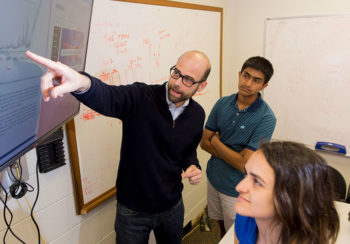For centuries, scientists have tried to crack the mystery of a devastating ailment once called “the shaking palsy.” But Parkinson’s disease, which causes tremors, muscle stiffness and difficulty walking, remains the second most common neurodegenerative disorder in the United States after Alzheimer’s. About 1 million Americans have Parkinson’s, and more than 50,000 new cases are diagnosed annually.
Drugs available to treat Parkinson’s can control symptoms but not slow progression. By the time its symptoms are evident, the disease already cut a swath of dead neurons through a crucial part of the brain.
University of Georgia Professor Anumantha Kanthasamy has a plan to fight back.
In 2021, Kanthasamy was appointed as UGA’s inaugural John H. “Johnny” Isakson Chair and Georgia Research Alliance Eminent Scholar in Parkinson’s Research. He is leading a new UGA initiative in brain science, including a state-of-the-art Center for Neurological Disease Research. He also spearheads an effort to recruit interdisciplinary researchers in neuroscience, epigenetics, bioinformatics and translational medicine. Four new faculty hires will start in Fall 2023.
“We need to detect Parkinson’s disease much sooner, which means we need to identify its diagnostic markers,” said Kanthasamy, who’s appointed in the College of Veterinary Medicine. “We also need new therapeutics to stop Parkinson’s from progressing. To do that, we must understand more about the disease’s underlying mechanisms.”
Not a brain-only disease
The immediate driver of Parkinson’s is dying nerve cells in a part of the brain known as “substantia nigra” (black substance), where neuromelanin-rich neurons produce the neurotransmitter dopamine that helps control movement. If these cells die, the brain’s dopamine supply falls, and eventually Parkinson’s symptoms become apparent.
For 60 years, the gold-standard treatment for Parkinson’s has been the drug levodopa (L-DOPA). A patient typically takes L-DOPA tablets three or four times a day, lifting dopamine levels in the brain. But the drug’s half-life is brief, and as it wears off between doses the benefit fades quickly, especially as the disease progresses. After about five years of sustained use, many patients develop distressing side effects—uncontrolled arm and head movements, for example.
“These side effects occur not because of Parkinson’s disease but because the most effective treatment is not delivered to the brain continuously,” Kanthasamy said.
Over the past decade, researchers have increasingly found evidence that neurodegenerative disorders can be triggered or accelerated by a sick gut. A healthy gut helps modulate immune responses. When it becomes chronically unbalanced—or “dysbiotic”—it can drive harmful inflammation that affects the brain.
“There has been an explosion of research and information about what goes wrong in the gut microbiome and how it impacts the brain,” Kanthasamy said. “But our work is different.”
He is leading a research team to understand a gut-microbe-brain communications channel, though with a new therapeutic twist. The gut microbiome includes trillions of bacteria, fungi and viruses, some of which are sending messages to the brain. The UGA team has gene-edited a probiotic to prompt the manufacture of a therapeutic by the patient’s body itself.
Someday, patients could swallow a probiotic pill that metabolizes in the gut to manufacture a small molecule, which circulates through the bloodstream into the brain. There it would convert to a crucial neurotransmitter for 12 to 24 hours, relieving Parkinson’s symptoms. In animal models, repeated dosing of the gene-edited probiotic provides continuous production of dopamine longer and can reduce or even eliminate side effects from current therapy.
As shown in this motion illustration, Kanthasamy’s lab has successfully demonstrated it can bioengineer a type of bacteria found in a patient’s microbiome—a.k.a., their gut—to stimulate manufacture of the neurotransmitter dopamine, helping Parkinson’s patients control body movement. (Illustration by Lindsay Robinson)
“We are turning the gut into a drug manufacturer of a safe, tolerable treatment for Parkinson’s,” Kanthasamy said.
The same engineered probiotic can also convert to norepinephrine, a therapy for dementia caused by Alzheimer’s or other neurodegenerative conditions. Kanthasamy and his team recently received grant support from the National Institute of Aging to study a gene-edited probiotic for dementia.
Parkinson’s was once seen as a brain-only disease, but scientists have growing evidence that its pathology could jump-start from the “periphery”—in the vagus nerve, the gastrointestinal system or even within an olfactory organ.
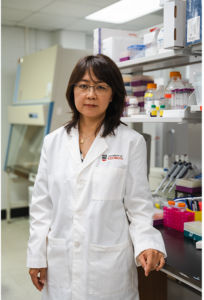
“We look at it more as a disease that can be initiated or spread from the brain to the body’s ‘periphery,’ but also as a disease that could be started from the periphery and then spread to the brain,” said Jae-Kyung (Jamise) Lee, associate professor in the Department of Physiology and Pharmacology.
Parkinson’s disease is related to other neurodegenerative disorders that fall under the umbrella term of “Parkinsonism.” These diseases affect primarily the elderly and share some—but not all—of the same diagnostic characteristics, such as nerve damage in certain parts of the brain and motor and (in some cases) cognitive deficits. They include Parkinson’s disease with dementia, dementia with Lewy bodies (proteins that mass in brain tissue), Alzheimer’s disease with Lewy bodies, and age-related dementia.

Other diseases could also fit into the broad Parkinsonism category. Some veterans who served during the 1990-91 Persian Gulf War suffer from fine-motor neurological deficits that resemble those of Parkinsonism.
“We are going to apply the knowledge we have garnered in researching Parkinson’s disease to other diseases that have Parkinsonian components,” said Nikolay Filipov, Sharma Distinguished Professor in the Department of Physiology and Pharmacology.
Cell messaging
Nearly every human disease involves messages between cells that go awry. UGA scientists are exploring cell-to-cell messaging to understand the underpinnings of neurodegenerative diseases.
Michael Tiemeyer, Distinguished Research Professor in the Franklin College of Arts & Sciences, joint director of the Complex Carbohydrate Research Center and interim director of the Center of Molecular Medicine, is studying the role of complex carbohydrates called glycans, which cover the surface of every living cell.
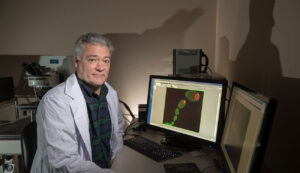
Glycans are crucial regulatory switches in the messaging networks between cells. When a pathogen threatens the brain, inflammatory cells are activated through glycan switches to fight it. When the danger is past, other cells tune down inflammation, again guided by messages through glycan networks.
Tiemeyer’s team has found that neurodegenerative diseases disrupt these glycan architectures.
“Glycans are normally keeping brain inflammation in balance, but then something goes wrong,” Tiemeyer said. “In neurodegenerative diseases like Parkinson’s and Alzheimer’s, this inflammatory balance is thrown off. Glycans start to activate one inflammation pathway more than another.
Big data and cell switches
Several years ago, spectacular leaps in sequencing and proteomic technologies began allowing scientists to study thousands of types of proteins from a sample. A single human cell might contain tens of thousands of proteins that change or evolve rapidly in response to the environment. Researchers have tracked proteins over time in search of, say, a potential early marker of Parkinson’s or a promising target for treatment.
Natarajan Kannan, a professor in Franklin’s Department of Biochemistry and Molecular Biology and the Institute of Bioinformatics, studies druggable protein families such as protein kinases and glycosyltransferases that determine how cells respond to diverse environmental signals. When this signaling goes haywire, neurodegenerative disorders can take root.
“We don’t have very effective treatments for the progression of neurodegenerative diseases because we don’t fully understand the signaling functions at the molecular level,” Kannan said.
But over the past few years, a technological revolution has opened new vistas in biology.
“We’ve seen massive advancements in computational biology and AI, where we can now start addressing diseases from a new lens,” Kannan said. “We aim to leverage advances in AI with data from different cell types, tissue types, disease types and even different organisms to develop predictive models of how proteins propagate their signals in diseases, particularly in neurodegenerative diseases.”
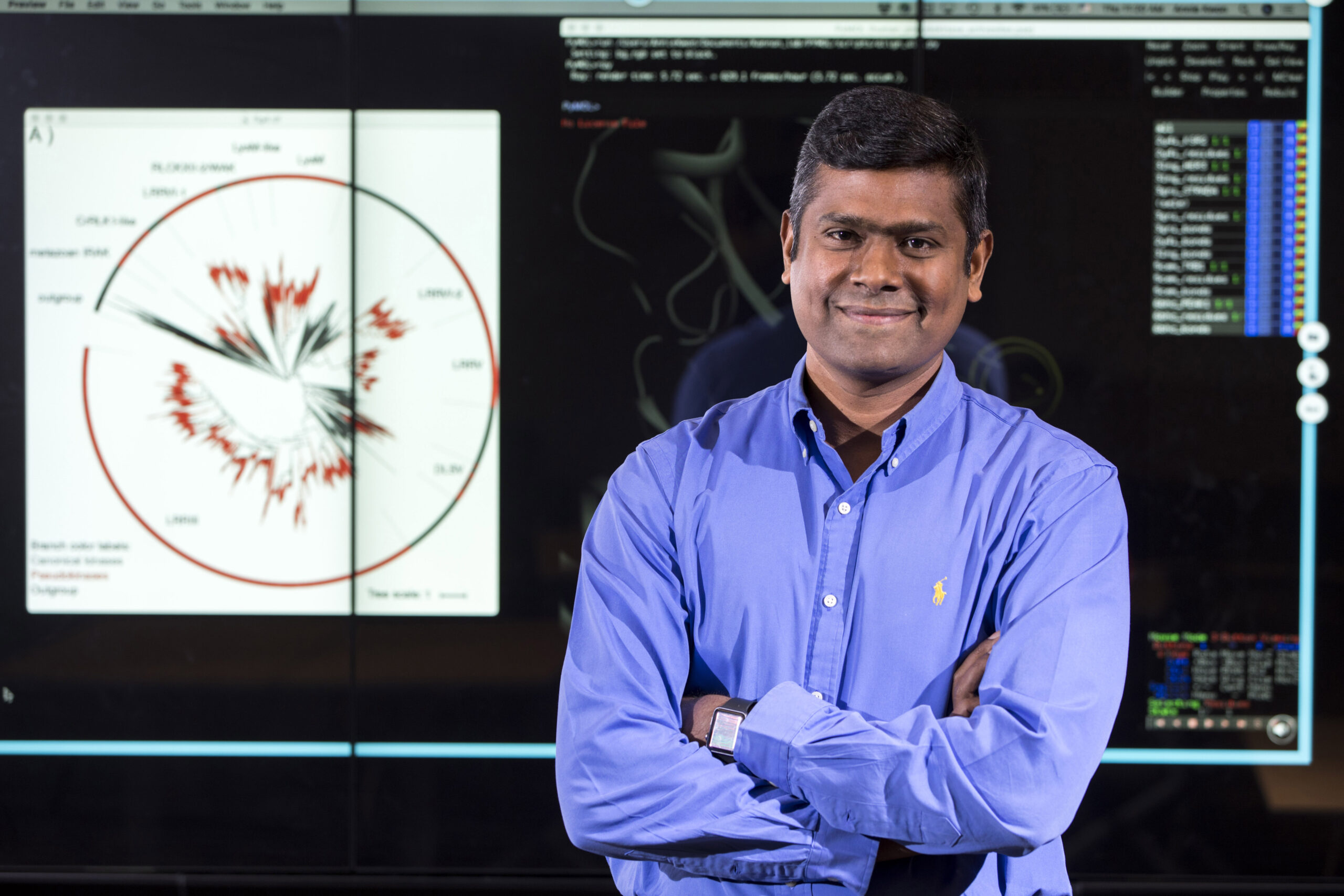
With biomedical sciences becoming increasingly data-intensive, quantitative, integrative and systematic, more biologists will participate in multi-disciplinary collaborations, Kannan said—partnerships the UGA brain center was designed to promote.
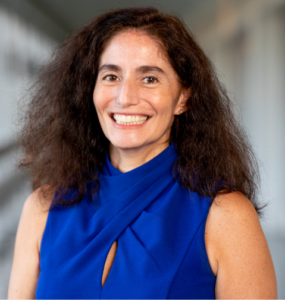
A particular kinase, LRRK2, is implicated in the most common genetic contributor to Parkinson’s. A gene mutation causes this enzyme to become overactive, starting a chain reaction of signals that destroys dopamine-producing brain cells.
Drugs in development that knock off these kinases are limited due to their toxicity.
Eileen Kennedy, Samuel C. Benedict Professor in the College of Pharmacy’s Department of Pharmaceutical and Biomedical Sciences, is exploring an innovative therapeutic strategy with help from the Michael J. Fox Foundation.
Kinases that are overactive in Parkinson’s are not self-starters—they must be sparked into motion, assembling into a particular shape to fire up kinases that help drive Parkinson’s. Instead of targeting the kinases directly with small-molecule drugs, Kennedy’s team aims to create inhibitors that constrain them from igniting and becoming destructive in the first place.

“We are developing completely different inhibitors,” said Kennedy. “We essentially want to disrupt the proteins’ ability to have that moving pattern required to have that kinase activity.”
Another potential area of impact is regenerative medicine. Steve Stice, D.W. Brooks Professor and Eminent Scholar Chair in Animal Reproductive Physiology in the College of Agricultural and Environmental Sciences, is hoping to soon move a regenerative medicine into human clinical trials that could help tame inflammation in the brain of Parkinson’s patients.
“Sen. Isakson advocated for regenerative medicine at UGA and elsewhere,” said Stice, who also directs the Regenerative Bioscience Center. “In 2007, we helped him propose legislation supporting ethical regenerative medicine therapies for diseases such as Parkinson’s.”
Diganostic markers and outreach
By the time an individual presents Parkinson’s symptoms, 50% to 70% of the brain’s dopamine-producing cells have been destroyed. One hallmark of a post-mortem Parkinson’s brain sample is the abundance of “misfolded” alpha-synuclein proteins.
In a healthy brain, these proteins fold neatly into shapes necessary for the tasks they perform. But in some neurodegenerative diseases, these proteins misfold and clump together in messy, damaging piles. Misfolded proteins cause biochemical reactions to misfire in cell pathways, driving brain inflammation and ultimately leading to degeneration of dopamine-producing neurons.
Arthi Kanthasamy, professor in CVM’s Department of Physiology and Pharmacology, studies what happens to the brain as these proteins fail to properly fold. She and her colleagues have shown that chronic exposure to pesticides and heavy metals can increase misfolded alpha-synuclein protein levels and brain inflammation. She is exploring potential therapies that target Parkinson’s as an autoimmune disease sparked by hyper-activated inflammatory cells in the peripheral nervous system.

“I am looking for novel therapeutics that could block this peripheral immune response and eventually prevent neurodegeneration,” Arthi Kanthasamy said. “When inflammatory cells migrate to the brain, they cause neuroinflammation that can go out of control, accentuating neurodegeneration and neural behavioral deficits. Identifying novel druggable targets for treating Parkinson’s disease is an urgent need, and we are striving towards developing a novel therapy.”
Misfolded proteins associated with Parkinson’s also have been found far from the brain—in peripheral nerve terminals in the skin, for example.
Before joining UGA, Anumantha Kanthasamy served as founding director of the Iowa State University’s Center for Advanced Neurotoxicology, where his team developed an assay that can detect misfolded proteins from skin samples.
“We could someday take a piece of skin tissue, even before the patient develops symptoms, and tell whether this person is likely to develop Parkinson’s or Parkinsonism,” Anumantha said. “Based on this work, the Michael J. Fox Foundation and NIH are providing grant support to our center’s biomarker discovery program. We hope to develop this potential diagnostic test over the next few years to get one approved for inpatient offices.”
“We could someday take a piece of skin tissue, even before the patient develops symptoms, and tell whether this person is likely to develop Parkinson’s or Parkinsonism.”
— Anumantha Kanthasamy, UGA’s inaugural John H. “Johnny” Isakson Chair and Georgia Research Alliance Eminent Scholar in Parkinson’s Research
Photo by Andrew Davis Tucker
Learning from rural Georgia
Alzheimer’s disease and related neurodegenerative diseases—including Parkinsonism—will likely cost the U.S. health care system more than $1 trillion by 2050. In Georgia, the number of people suffering from these diseases is expected to increase by nearly 40% within the next few years, and many of the patients will live in rural areas.
“Rural populations tend to be a little bit older, and one of the major risk factors for a neurodegenerative disorder is age,” said Lisa Renzi-Hammond, associate professor in the College of Public Health, director of the Institute of Gerontology and co-director of the Cognitive Aging Research and Education (CARE) center.

CARE works in 11 rural counties across the state, providing education on brain health and dementia prevention and helping improve access to diagnoses. CARE conducts scholarship among people who have been underrepresented in research, such as rural Georgians.
“We hold community forums, hearing from local groups made up of folks who are eager and interested in tackling neurodegenerative diseases,” Renzi-Hammond said. “We aim to earn their trust and engage them in that research process. We are not simply recruiting research participants. This is about serving our communities and recognizing that research is a big part of service. We want to ensure that the therapies we create can reach the bedsides of the people who need them most.”






